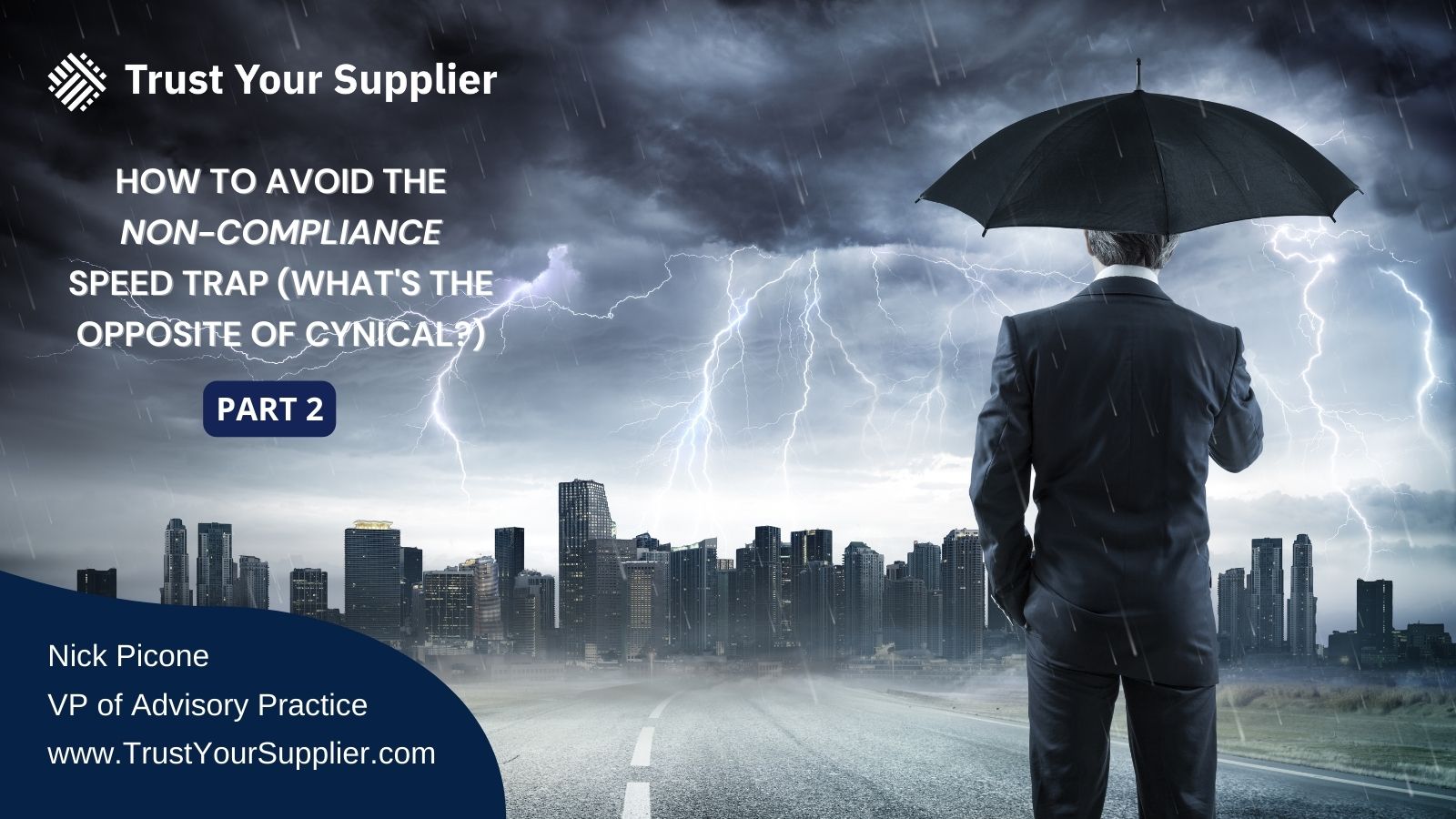by Nick Picone, Trust Your Supplier VP of Advisory Practice
In my last post, I shared my thoughts on the coming regulatory headwinds and potential financial implications that all companies that lack efficient and effective supplier management capabilities will eventually face.
Today, I want to share insights from conversations I’ve had with leaders across the supply chain, procurement, and compliance officers at the various conferences I’ve attended with my team over the last three months.
Risk is Increasing
Nearly every discussion I had involved an extraordinary level of intellectual curiosity about what my company TYS does and what I saw in my day-to-day role as we partner with companies across the globe on their risk and compliance transformation initiatives.
I explained that nearly everyone understands they lack the comprehensive visibility across their supplier base to effectively manage risk and compliance at scale. I also shared a reasonably bold opinion that many companies I am meeting with face the increased risk of a supply chain extinction-level event due to a perfect storm across their small and middle-tier suppliers.
Some people challenged my position – which you expect – or mentioned that the level of risk I was referring to did not apply to their company which I was also willing to debate. The good news is that nearly all were interested in understanding why I thought the way I did and what I was looking at or seeing that shaped my view.
I explained that small and medium-tier suppliers are most at risk from this “perfect storm” we all face. It is especially important to recognize that these small and medium-tier suppliers could also be strategic and to understand the risk most companies face today by only focusing on their top-tier suppliers due to cost and complexity issues. In other words, companies generally have very little clarity into the situation beyond the first-tier suppliers until it’s too late.
Pre-COVID Survival
Before the pandemic and the world-changing events of the past few years, many small to medium-sized companies were practically on life support, and continued to exist because of favorable lending standards and the abnormally low cost of capital over the previous fourteen-year period. These historically low rates and easier access to credit provided a lifeline to businesses, particularly small and middle-tier suppliers who barely made it and primarily relied on regional banks to provide access to capital.
The Perfect Storm
Today, the problems we face as a society are well known. We find ourselves in a new environment; the optimal operating conditions of the past have quickly eroded and created the previously alluded to perfect storm characterized by exploding interest rates, tightening lending standards (especially across regional banks), inflation, geopolitical risk, and shortages across the supply chain. These events, taking place concurrently, are creating the most challenging financial climate – and operating environment for business – in at least fifty years. As a result, there is a dramatic increase in the risk of a significant shock to the global financial system that begins with regional banks and will ultimately impact companies and consumers.
Supporting Data
It may seem bold to suggest that many – okay, a significant portion of a company’s supply base may not be in business in 18 months. I realize that it is impossible to predict the future. Still, it is possible to see around corners, especially when you have complete visibility over your supplier base and access to instant real-time intelligence.
For example, let me share several “sobering” present-day statistics that will illustrate just how much stress your small and middle-tier suppliers are under – particularly diverse suppliers.
A record number of small businesses folded during the pandemic, and African American businesses were unfortunately “the hardest hit” with a drop of 41%, followed by a 32% decline in Latino-owned businesses.” As a point of comparison, the decrease in white-owned businesses was 17%.
Those numbers are hard to accept for some, which is understandable because they surprise many.
The Opposite of Cynical – Clarity
I understand technically, the opposite of cynicism is optimism. However, for anyone to become optimistic – which I am, by the way – I believe you need a clear line of sight to understand your current reality – where you are, where you want to go, and what you must overcome to get there.
However, you can only achieve your goals with a solid and stable supply base that includes your small and medium-tier suppliers.
The two questions you now must ask – and be able to answer, how stable and resilient is your value chain beyond your tier-one suppliers? How do you really know?


0 Comments